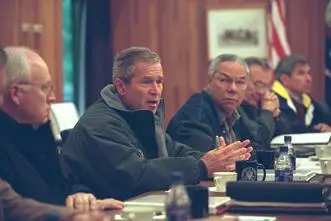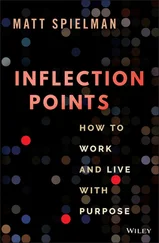About a quarter mile down the hill is Laurel, a large lodge with a spacious dining area, a small presidential office, and a wood-paneled conference room that Jimmy Carter used when he negotiated the Camp David Peace Accords.
That was where my national security team gathered on Saturday morning, September 15, to start developing the battle plan for Afghanistan. The mood was somber, serious, and focused. With me at the big oak table were the top national security officials from across the government.* Together they had decades of crisis management experience.

Meeting with Dick Cheney, Colin Powell, and my national security team at Camp David the Saturday after 9/11. White House/Eric Draper
The first key presentation that morning came from CIA Director George Tenet. Six months earlier, at my direction, George and the National Security Council had started developing a comprehensive strategy to destroy the al Qaeda network. In the four days between 9/11 and the Camp David meeting, the CIA team had beefed up their plan. George proposed that I grant broader authority for covert actions, including permission for the CIA to kill or capture al Qaeda operatives without asking for my sign-off each time. I decided to grant the request.
The heart of the CIA plan was a new offensive in Afghanistan, where 9/11 had been planned. The roots of the terrorist presence in Afghanistan traced back to 1979, when the Soviet Union invaded and installed a communist puppet regime. Afghan tribes, along with a band of hard-core Islamic fighters known as the Mujahideen, rose up against the foreign occupation. With assistance from the United States, Pakistan, and Saudi Arabia, the rebels inflicted fifteen thousand casualties and drove out the Soviets in 1989. Two years later, the superpower collapsed.
Free of the communist occupiers, the Afghan people had a chance to rebuild their country. But the U.S. government no longer saw a national interest in Afghanistan, so it cut off support. America’s noninvolvement helped create a vacuum. Tribal warriors who had defeated the Soviets turned their guns on one another. Ultimately, the Taliban, a group of Islamic fundamentalists, seized power. They imposed a fanatical, barbaric brand of Islam that prohibited girls from going to school, required men to grow beards of a certain length, and forbade women from leaving their homes without a male relative as an escort. The simplest pleasures—singing, clapping, and flying kites—were banned.
The Taliban’s rules were enforced by brutal religious police. A 1998 State Department report described a woman struggling to carry two small children and a load of groceries on a street in Mazar-i-Sharif. When her body-length burqa slipped from her face, she was beaten with a car antenna. Petty thieves were taken to the national soccer stadium to have their limbs hacked off.
Homosexuals were stoned to death, as was anyone suspected of adultery. Shortly after the Taliban seized Kabul, they kidnapped the former president of Afghanistan from his UN compound. After beating and castrating him, they hung his body from a lamppost. In Bamiyan Province, home to the minority Hazaras, the Taliban massacred at least 170 innocent civilians in January 2001. Later that year, they dynamited two cherished 1,500-year-old Buddha sculptures.
There were some who received warm hospitality from the Taliban. Shortly after taking power, the radical mullahs offered sanctuary to Osama bin Laden, the founder of al Qaeda. Between 1996 and 2001, bin Laden established camps in Afghanistan that trained an estimated ten thousand terrorists. In return, bin Laden drew on his personal fortune to fund the Taliban. By 9/11, Afghanistan was not only a state sponsor of terror, but a state sponsored by terror.
While the Taliban’s ideology was rigid, its control of the country was not. In a small section of northern Afghanistan, a group of tribal commanders called the Northern Alliance held the allegiance of the local population. On September 9, 2001, bin Laden operatives assassinated the Northern Alliance’s beloved leader, Ahmad Shah Massoud. His murder galvanized the Alliance to cooperate with America. We shared an enemy and a determination to end Taliban rule.
George’s plan called for deploying CIA teams to arm, fund, and join forces with the Northern Alliance. Together they would form the initial thrust of the attack. By mating up our forces with the local opposition, we would avoid looking like a conqueror or occupier. America would help the Afghan people liberate themselves.

We would not act alone. Colin Powell had done an impressive job rallying countries to our coalition. Some, such as Great Britain and Australia, offered to deploy forces. Others, including Japan and South Korea, pledged humanitarian aid and logistical support. South Korea later sent troops. Key Arab partners, such as Jordan and Saudi Arabia, shared sensitive intelligence on al Qaeda’s operations.
The most pivotal nation we recruited was Pakistan. No country wielded more influence in Afghanistan than its eastern neighbor. On 9/11, Pakistan was one of only three countries that recognized the Taliban. Saudi Arabia and the United Arab Emirates were the other two.
Some in Pakistan may have sympathized with the Taliban’s ideology. But the primary motive was to counterbalance India, Pakistan’s bitter archrival. So long as Pakistan held the loyalty of Afghanistan’s government, it would never be encircled.
Pakistan had a troubled history with the United States. After our close cooperation in the Cold War, Congress suspended aid to Pakistan—including coveted F-16s America had promised to sell them—out of concern over the government’s nuclear weapons program. In 1998, Pakistan conducted a secret nuclear test, incurring further sanctions. A year later, General Pervez Musharraf overthrew the democratically elected government in a coup. By 2001, America had cut off virtually all aid to Pakistan.
On September 13, Colin called President Musharraf and made clear he had to decide whose side he was on. He presented a list of nonnegotiable demands, including condemning the 9/11 attacks, denying al Qaeda safe haven in Pakistan, sharing intelligence, granting us overflight rights, and breaking diplomatic relations with the Taliban.
Musharraf faced intense internal pressure. Turning against the Taliban was unthinkable for hardliners in his government and intelligence service. I called Musharraf from Camp David during a break in the war council meeting. “I want to thank you for listening to our sad nation’s requests, and I look forward to working with you to bring these people to justice,” I said.
“The stakes are high,” Musharraf told me. “We are with you.”
Our relationship with Pakistan would prove complex. But in four days we had turned Afghanistan’s pivotal neighbor from a supporter of the Taliban to a partner in removing them from power.

The next presentation came from the military. Don Rumsfeld called on Joint Chiefs Chairman Hugh Shelton, an Army Ranger in his final month on the job, and Vice Chairman Dick Myers, the Air Force general I had nominated to take his place. They walked me through three options.
The first was the Pentagon’s contingency plan, the preexisting strategy to be used in an emergency. It called for cruise missile strikes on al Qaeda camps in Afghanistan. The plan could be executed immediately, with no risk to American troops.
The second option was to combine cruise missile strikes with manned bomber attacks. This would allow us to hit more targets, while exposing our pilots to limited risk.
Читать дальше













